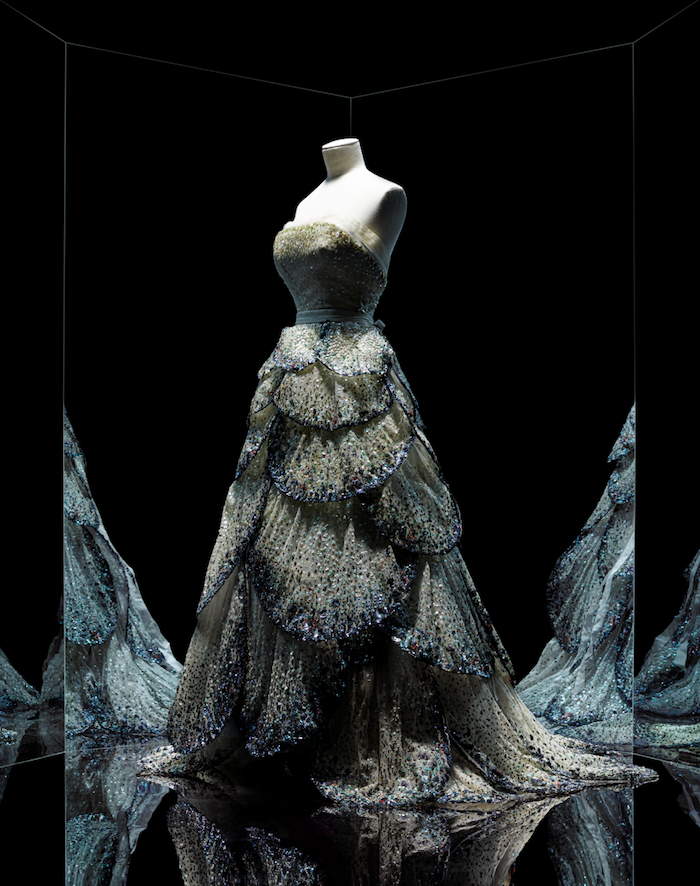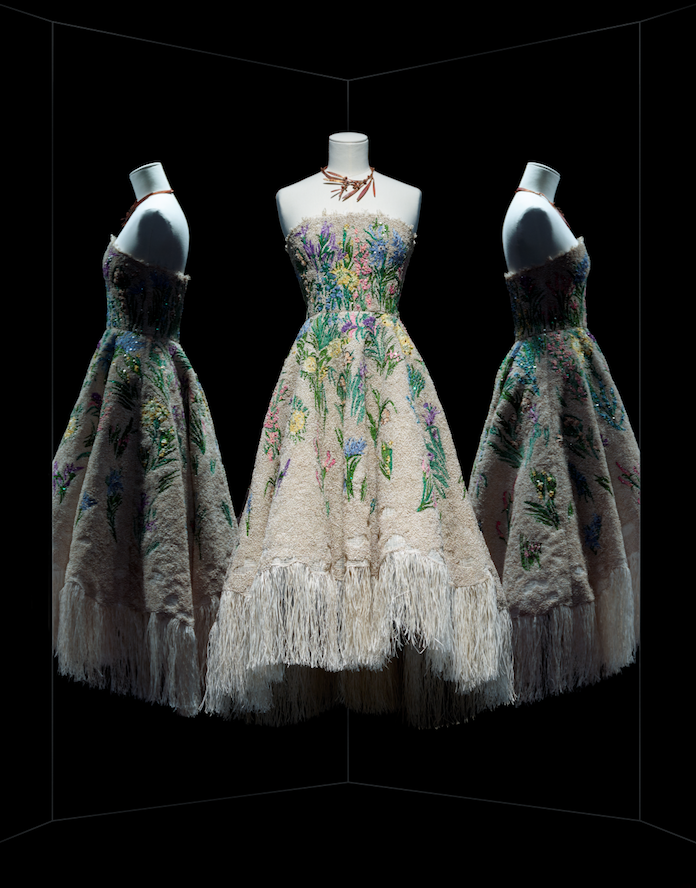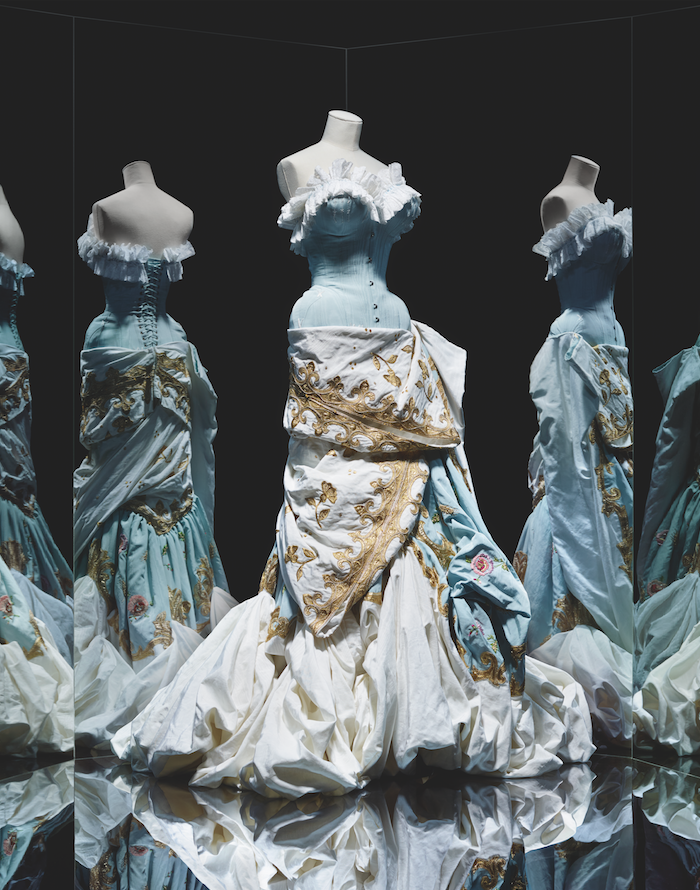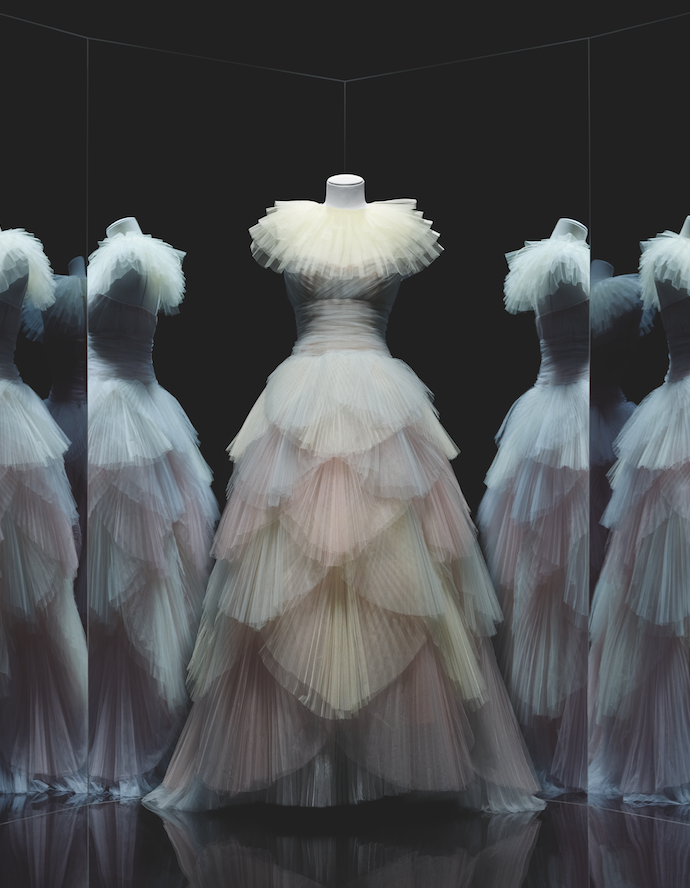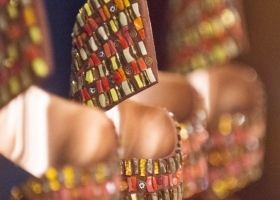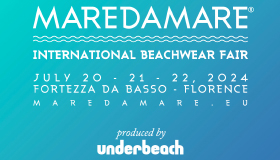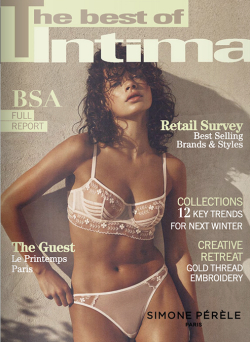
The Best ofIntima & Swim Edit
Christian Dior, Designer of Dreams
25 January 2018
FROM THE 5TH OF JULY UP TO THE 7TH OF JANUARY, PARIS’ ARTS DÉCORATIFS MUSEUM CELEBRATED, FASHION HOUSE, CHRISTIAN DIOR’S 70TH ANNIVERSARY.
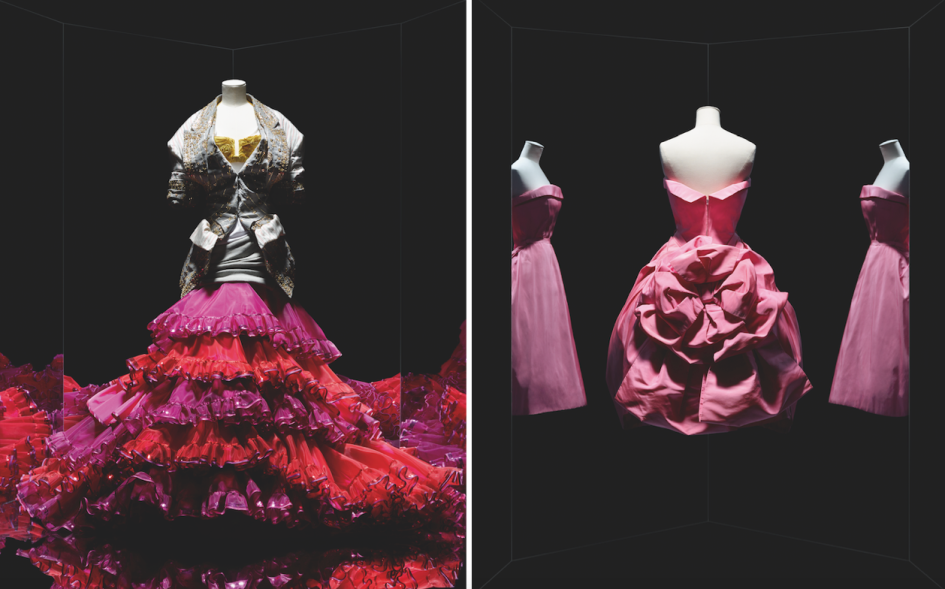
Photo on the right : Christian Dior, Opéra Bouffe gown, haute Couture, Fall-Winter 1956, Aimant line Short evening gown in silk faille by Abraham. Paris, Dior héritage
© Photo Les Arts Décoratifs / Nicholas Alan Cope
Visitors were invited on a voyage of discovery through the universe of the house of Dior’s founder and the great couturiers who succeeded him: Yves Saint Laurent, Marc Bohan, Gianfranco Ferré, John Galliano, Raf Simons and most recently Maria Grazia Chiuri. The curated selection of 300 haute couture gowns designed from 1947 to the present day carries a unifying thread of emotions, life stories, affinities, inspirations, creations, and legacies. Beside this breathtaking collection, are hundreds of documents (including illustrations, sketches, documentary photographs, letters, notes and advertising) alongside a wide range of fashion accessories (such as hats, jewelry, bags, shoes and perfume bottles). Designs from over 70 years interact with a selection of paintings, furniture, and works of art which reflect the fact that Christian Dior was a knowledgeable art lover who loved museums. These works develop our outlook on Christian Dior as they explore the ties he forged between couture and all forms of art, defining the house of Dior’s enduring influence. The exhibition's two curators, Florence Müller and Oliver Gabet, convey their message with a chronological and themed exhibition design that inhabits and brings together the museum’s fashion areas and the Nave building together for the first time to form an exhibition over its 32,291 square feet. The exhibition may have passed but The Best of Intima takes you through the universe of Dior, immersing you in the creations of one of the greatest fashion houses of all time and its six creative directors who created the image of Dior that we know today.
First photo: Christian Dior, Junon gown, haute Couture, Fall-Winter 1949, Milieu du siècle line Long crinoline evening dress embroidered with sequins by Rébé. Paris, Dior héritage © Photo Les Arts Décoratifs / Nicholas Alan Cope
Second photo: Maria grazia Chiuri for Christian Dior, Essence d’herbier cocktail dress, haute Couture, Spring-Summer 2017. Ecru fringe cocktail dress, floral raffia and thread embroidery adomed with Swarovski crystals, derived from a Christian Dior original embroidery© Photo Les Arts Décoratifs / Nicholas Alan Cope
Fourth photo: Maria grazia Chiuri for Christian Dior, New Junon dress, Spring-Summer 2017, haute Couture collection © Photo Les Arts Décoratifs, Paris / Nicholas Alan Cope
70 YEARS OF CREATION
The last Parisian retrospective dedicated to Christian Dior was held in 1987, also in the Arts Décoratifs Museum. It focused on ten years of the couturier’s designs from 1947 to 1957. To celebrate the house of Dior’s seventieth anniversary, the new retrospective shows how Christian Dior and the six artistic directors who followed on his heels devised the brand and built up the influence of a name that is the very embodiment of haute couture in France and throughout the world. Yves Saint Laurent, Marc Bohan, Gianfranco Ferré, John Galliano, Raf Simons and today’s director, Maria Grazia Chiuri, have all drawn on their own creative sensibilities to formulate a style and a vocabulary that stay true to the original concept and to help define the house of Dior’s identity through the prism of its relationship to its era. This exploration of haute couture is enriched by Frédéric Castet’s fashion fur designs, beautiful creations by Serge Lutens, Tyen and Peter Philips, as well as perfume creations by François Demachy.
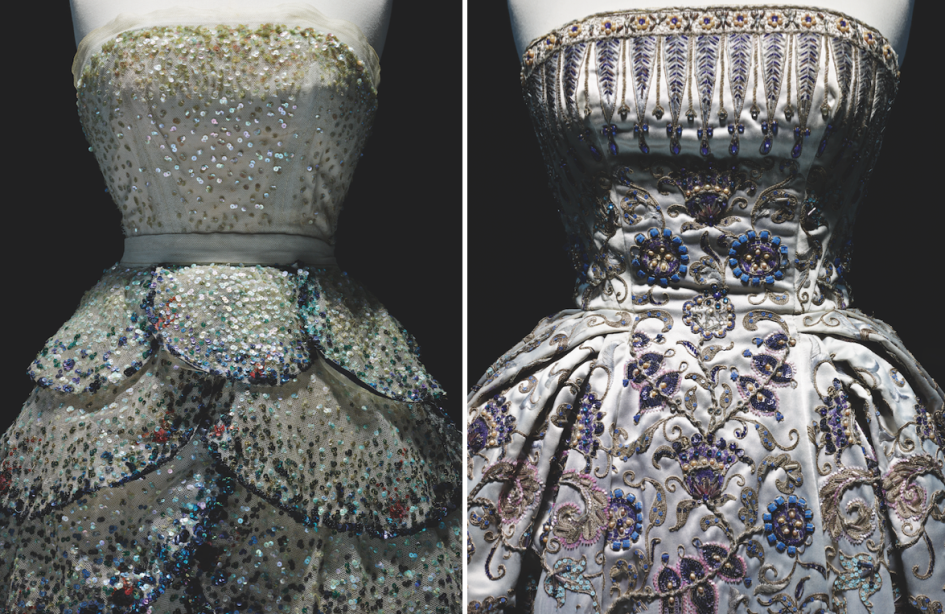
Photo on the right: Christian Dior, Palmyre gown, Fall-Winter 1952 haute Couture collection, Profilée line, evening gown in satin by robert Perrier, embroidered with Swarovski crystals, metallic thread, gemstones, pearls and sequins by ginesty, Paris, Dior héritage
© Photo Les Arts Décoratifs, Paris / Nicholas Alan Cope
BETWEEN ART AND FASHION
A leading figure in the world of 20th- century fashion once he launched his new look Spring-Summer collection in 1947, Christian Dior took the feminine shape in a totally new direction, relegating the masculine silhouette of the war years to the past. His dresses expressed a modern femininity, incarnated by his flower-woman and produced a shape characterized by flowing curves and the bearing of a classical ballet dancer. The new look featured soft shoulders, accentuated busts, nipped-in waists and hips amplified by swirling corolla- like skirts. Christian Dior relaunched the textile industry with his insistence on the use of great swaths of fabric, a controversial move after the years of shortage under the occupation. He succeeded in breathing new life into the couture tradition, giving a central role to embroiderers and craftspeople making costume jewelry and accessories. He invented an internationally-focused couture that put Paris back in the spotlight as the capital of fashion. The exhibition opens with the story of Christian Dior’s life: his childhood in Granville, the Roaring twenties when he discovered the avant-garde art world and the pleasures of Parisian entertainment, his training as a fashion illustrator and his entry into the haute couture world. Before turning to fashion, Christian Dior ran an art gallery from 1928 to 1934 in partnership with his friends, first Jacques Bonjean then Pierre Colle. This part of his life is illustrated with a series of paintings, sculptures, and documents that depict an eclectic approach to curating, the older generation of established artists rubbing shoulders with their younger counterparts, Dior’s peers. These up-and-coming talents included Giacometti, Dalí, Calder, Leonor Fini, Max Jacob, Jean Cocteau and Christian Bérard. Christian Dior was a lover of antiques and objets d’art, an art nouveau collector, a decorator enthralled by the 18th century and a garden enthusiast. He drew on all these sources of inspiration to embellish his private residences and define the aesthetic for his couture house and designs. The exhibition shows us that his gowns were full of references to painting and sculpture as well as everything that makes up the art of living: wallpapers, fabrics, china, and chinoiserie.
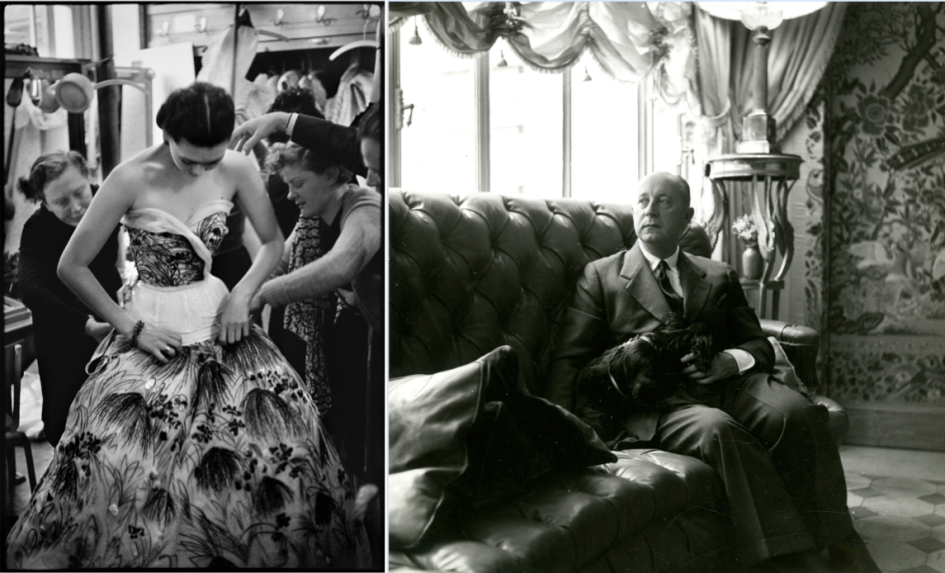
Photo on the left: Henri Cartier-Bresson, model Alla having the May dress fitted before the fashion show, 1953, © Henri Cartier-Bresson / Magnum Photos
Photo on the right: Christian Dior in his apartment at 7 Boulevard Jules-Sandeau in Paris, ca. 1950 © Christian Dior
A JOURNEY THROUGH TIME
All these creative themes have become an integral part of the Dior spirit as they have been revisited by the successors of Dior. Revealed one by one throughout the exhibition, among the range of themes on display are: art and photography, a profusion of colors and textures, austere Parisian elegance, references to the neoclassical decorative style, the joys of exoticism and a fascination for floral motifs. Nathalie Crinière presents the themes in successive settings that are suggestive of an art gallery, Dior’s ateliers, Avenue Montaigne, a boudoir, journeys and a fabulous garden. Throughout, paintings, sculptures and decorative objects illustrate the couturier’s tastes and sources of inspiration as well as a creative sensibility shared by all the artistic directors who have followed in his footsteps. The visit continues into the Nave area of the museum where a chronological display spanning the 70 years from 1947 to 2017 shows the energy that set it all in motion and the legacy of Dior’s spirit down the years. The iconic shape of the “Bar suit” that embodies the New Look opens the door to this voyage through time. The black-and-white ensemble demonstrates every aspect of the innovation Dior introduced with his new aesthetic, triggering a golden age of fashion. The suit has continued to haunt the imagination of the fashion world and many of its couturiers and designers ever since. But the enduring nature of the Dior spirit also stems from the different artistic directors who carried on the couturier’s work after his death in 1957. A succession of six galleries is dedicated to these figures, analyzing how their designs contributed to the quest to stay faithful to Dior’s vision of haute couture. The daring choice of the young Yves Saint Laurent was followed by Marc Bohan’s more rational appointment. Next came the flamboyant arrival of Gianfranco Ferré, the dramatic era of fashion punk John Galliano, the minimalist statement of Raf Simons’ appointment and most recently, a female creative director, Maria Grazia Chiuri and her feminist vision of fashion.
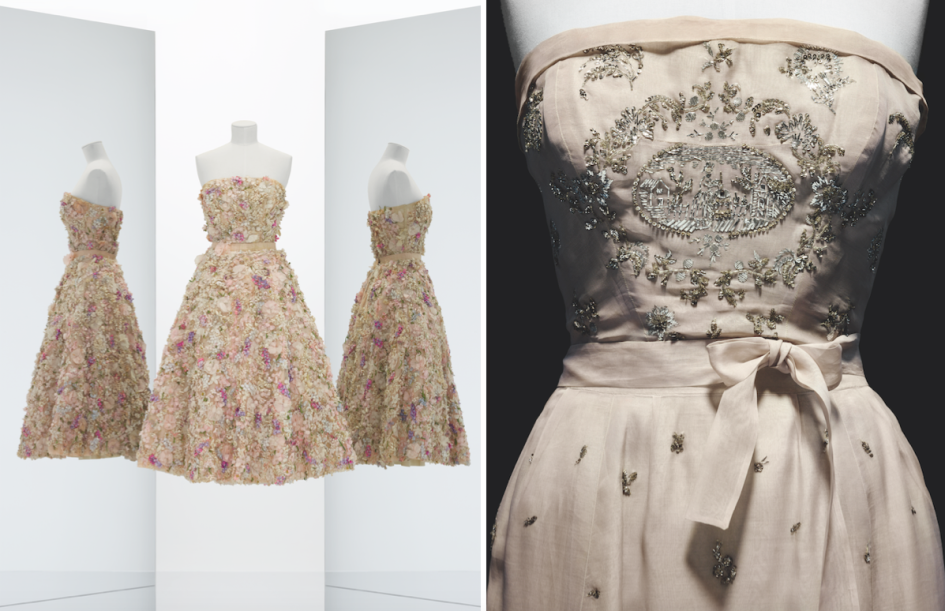
Photo on the left: Christian Dior, Miss Dior dress, Spring-Summer 1949 haute Couture collection, Trompe-l’oeil line, short evening dress embroidered with flowers by Barbier Paris, Dior héritage
© Photo Les Arts Décoratifs, Paris / Nicholas Alan Cope
Photo on the right: Christian Dior, Trianon gown, Spring-Summer 1952 haute Couture collection, Sinueuse line, evening gown in organdy by Jean Page, embroidered with lamé, metallic sequins and silver beads. Palais galliera, Musée de la Mode de la Ville de Paris, gift of Francine halphen-Clore, 1984
© Photo Les Arts Décoratifs, Paris / Nicholas Alan Cope
THE EVOLUTION OF DIOR'S SILHOUETTE
The expertise and techniques that are the lifeblood of haute couture are presented in an atelier where seamstresses are at work surrounded by models, dressmakers, sketches and toiles.
One of the galleries provides an overview of how the Dior line and allure have developed since 1947, illustrated with gowns and extracts of films and catwalk show videos. The exhibition ends in the lavish setting of the nave, transformed into a ballroom for a presentation of a series of truly sumptuous ball gowns, including several glittering creations seen together for the first time in Paris. Some of them have been worn by famous customers who have helped to build the success of the House of Dior, including Princess Grace of Monaco, Princess Diana, Charlize Theron and Jennifer Lawrence. An unusual member of this family of ball gowns, unearthed thanks to research for this project, is a dress named, “Soirèe Brillante”, presented at the Musée des Arts Décoratifs during Christian Dior’s time in November 1955, on the occasion of an exhibition of pieces by leading 18th-century French cabinetmakers. Christian Dior was one of the people who lent objects to the exhibition, and the presence of his designs turned the inauguration into a fashionable and elegant cultural event. In fact, on the day of the event, Dior models strolled around the show in gowns, posing among the pieces of furniture and objets d’art. This highlights the part that women’s couture plays in the applied arts and the role played by Christian Dior himself in the history of decorative arts.
Most of the works featured in this ambitious project are from the Dior Hèritage collection, while the remaining pieces are special loans from the collections of the Musée des Arts Décoratifs and Union Française des Arts du Costume, Palais Galliera, Costume Institute at the Metropolitan Museum of Art in New York, Victoria and Albert Museum in London, De Young Museum in San Francisco, Fondation Pierre Bergé-Yves Saint Laurent, Museum of London and Musée Christian Dior in Granville. There are also prestigious works of art representing many different eras, from the collections of the Musée du Louvre, Musée d’Orsay and Musée de l’Orangerie, Château de Versailles, Centre Pompidou, Musée des Arts Décoratifs and numerous private collections.
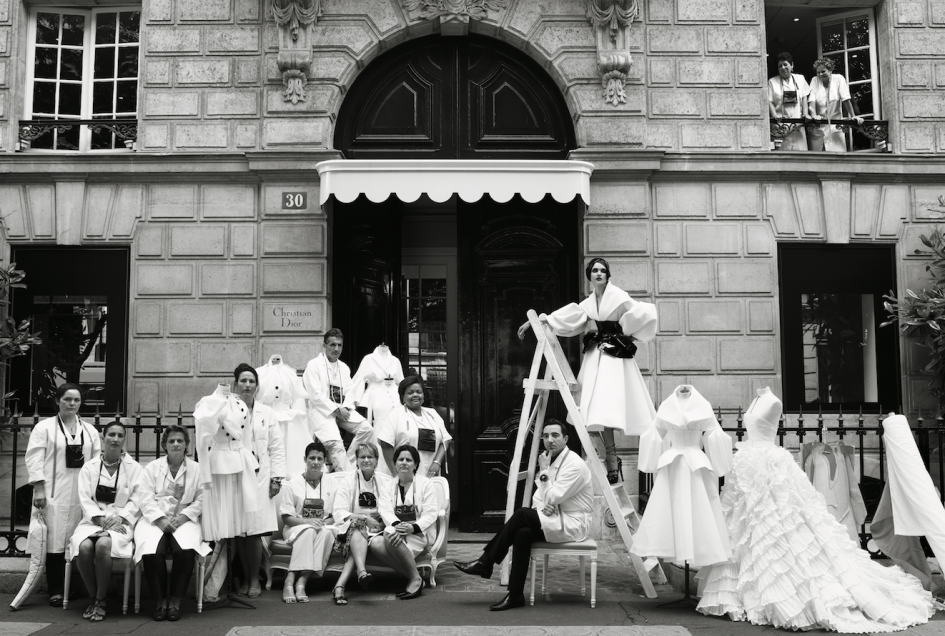
Copyright 2024. All right reserved - Terms
